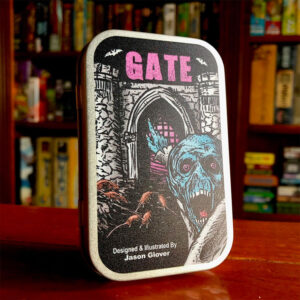 Some board games have become large sprawling monstrosities taking over tables and shelves thanks in part to Kickstarter and a trend of adding heaps of plastic miniatures into oversized boxes. Gate, designed and illustrated by Jason Glover—the one-man show at Grey Gnome Games—is made to order at thegamecrafter.com. Gate is the antithesis of that trend arriving in a small mint tin.
Some board games have become large sprawling monstrosities taking over tables and shelves thanks in part to Kickstarter and a trend of adding heaps of plastic miniatures into oversized boxes. Gate, designed and illustrated by Jason Glover—the one-man show at Grey Gnome Games—is made to order at thegamecrafter.com. Gate is the antithesis of that trend arriving in a small mint tin.
Gate is a tower defense game in a medieval/low fantasy setting that features some light deckbuilding and a constant push-pull between attacking advancing enemies to remove them from the board before they do more damage, buying new cards, calming the population, and repairing the damage being done to your waylaid village.
Gate is a single-player game that takes 15 to 20 minutes to play.
Gameplay Overview:
Each citizen and hero card has four icons for income, repair, calm, and attack with numbers by each to represent their respective values. Some citizen and hero cards also have special abilities. Heroes are single-use cards that you get as the fear track moves up the Fearamid (fear + pyramid).
Each turn starts with the Enemy Advancing which flips over a new enemy card. If there are already two enemies on the board, the one furthest to the left attacks the Gate for one point of damage and is then discarded. That doesn’t seem so bad, but, don’t worry, the two enemies on the table get to attack later.
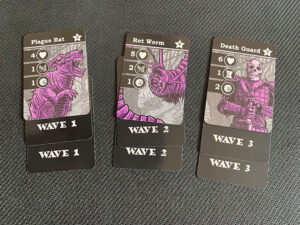
Next, the player gets to draw cards until they have three in their hand. Each citizen can use one of its icons each turn to do one of three actions. The game breaks these down in a specific order but, as far as I can tell, it may not matter since each card can only be used once.
Commands: The player can spend coins on several different commands like Attacking (Call to Arms), replacing your hand of cards (Caravan), calming the population (Festival), and repairing your village (Fortify).
Recruit: The player can purchase citizens from the four face-up cards in the market. Every time a citizen is purchased they are added to the discard pile, and another is immediately added to the market.
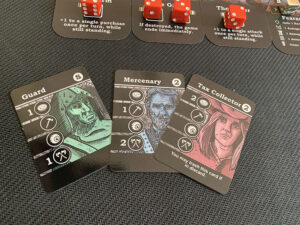
Play cards: Use any remaining cards to attack enemies, repair buildings, and calm your population. You get a once per turn bonus for purchasing and doing damage if your farm and tower still have dice on them. As you damage enemies you add damage crystals to them, killing them when their damage reaches the value on their card. Leftover damage can be placed on the other enemy rampaging against your village as does leftover repair points repairing your buildings. Defeated villains go into a pile of vanquished foes which becomes your score when the game ends; assuming you didn’t lose outright.
Lastly, after you feel like you’ve got things under control, the enemies attack inflicting damage to the target listed on their card and increasing the fear shown on the Fearamid. Certain steps on the Fearamid allow you to draw a hero into your discard pile (yay!) while others do damage to parts of your village (boo!). And if you ever reach the final spot—you lose.
Enemies continue to advance until you reach the last two—which becomes the final stand. Here you must defeat the last two villains as they continue their relentless assault on your poor village.
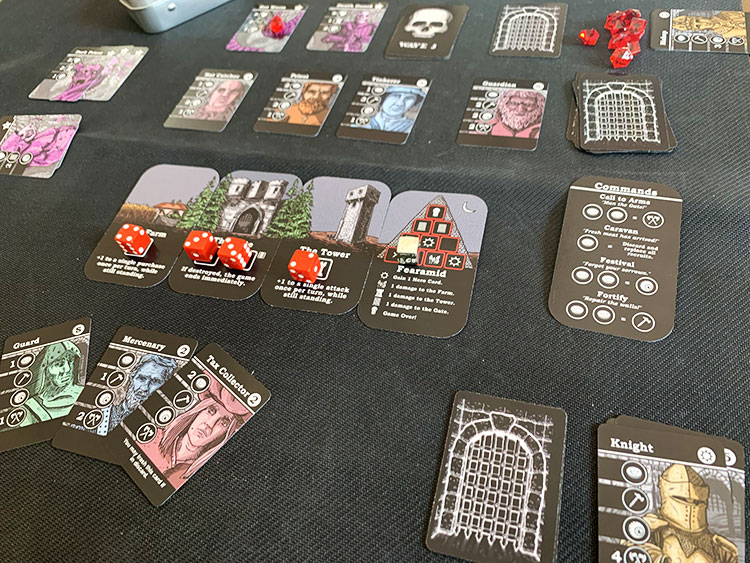
Game Experience:
This is a game where you may think “I’ve got this” as you finish your turn and then the enemy goes and you hear the narrator voice in your head say, “No. You don’t have this.”
The information is all in front of you so you can see how much damage the enemies will do, how much fear they’ll inflict, and the effect from it. That’s a nice way of saying that you have no one to blame but yourself when you lose. But, you will lose from time to time due to making poor choices, not drawing the cards you need, or what’s available in the market.
If the market doesn’t have cards you want (or can afford) you can feel like you’re wasting turns purchasing a card you don’t want hoping that it gets replaced by a better card. Every card has a use but sometimes it’s not what you need at the moment. Likewise, you may end up with an awesome hero that you don’t want to use yet which limits you for a turn or two as you hoard that valuable card. Despite the luck aspect, I think a skilled player will be able to solve the puzzle presented with the pieces they have. Bad stuff happens but it’s at a metered pace.
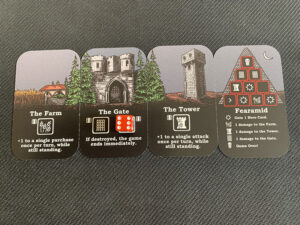
At its heart, besides being tower defense, Gate is a simple deck builder where you’re constantly trying to improve your deck and make the best decisions possible with your limited hand size. Every game has tense moments as you try and balance the actions with the cards you have.
The game leans towards the easy side for a solo game and I’d estimate I’ve won three-quarters of the games I’ve played. The game became easier once I realized that I should let some enemies take that free hit at the Gate instead of wasting energy attacking them and then have them damage their gate on their way out anyway.
The biggest downside so far in Gate is the lack of variety in enemies and Heroes. There are nine enemies and five heroes and you’re likely to see all of them in every game. Jason has mentioned the possibility of an expansion in the works. Another downside is, while there are some decisions to be made, it may become fairly easy to identify the optimal answer after a few plays.
Final Thoughts:
Overall Gate provides a good gaming experience in a short time frame. I find it’s hard to find a solo game that’s satisfying and an appropriate length. Some games overstay their welcome while other games end just as you feel like you’re hitting your stride. Gate hits a sweet spot where it’s engaging, builds tension, and ends before it gets tedious.
Final Score: 3.5 Stars – Good game in a small package.
 Hits:
Hits:
• Fast playing and engaging
• Small gaming footprint and packaging
• Good decision space utilizing a small number of resources
Misses:
• Need more variety for Heroes and Enemies
• Can see short term effects so clearly that the player can often see the obvious choice
• May be a little too easy





















